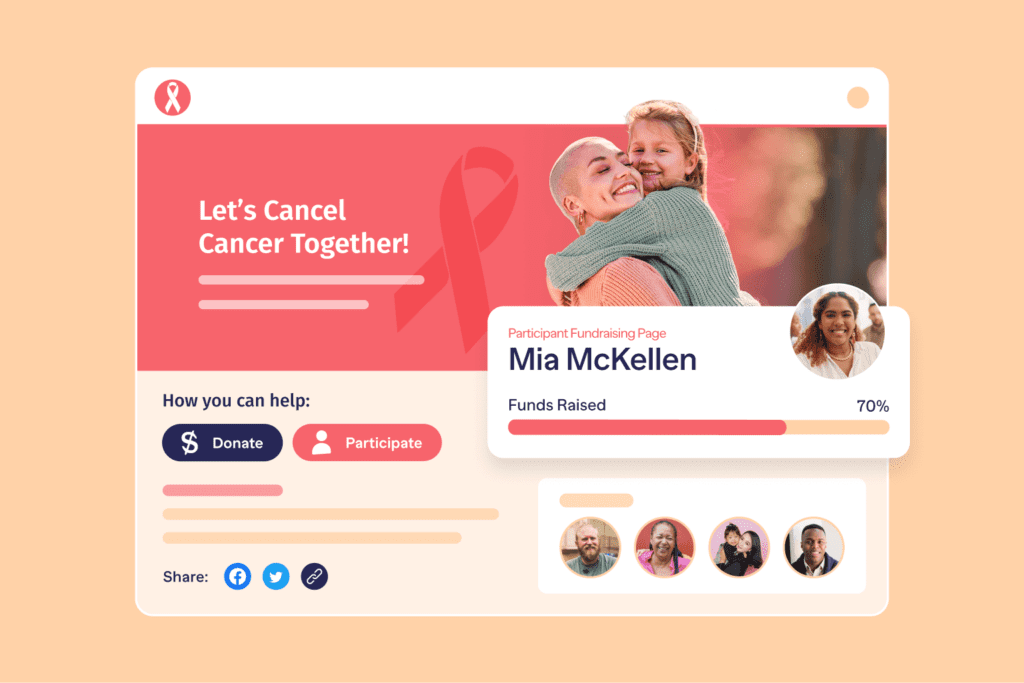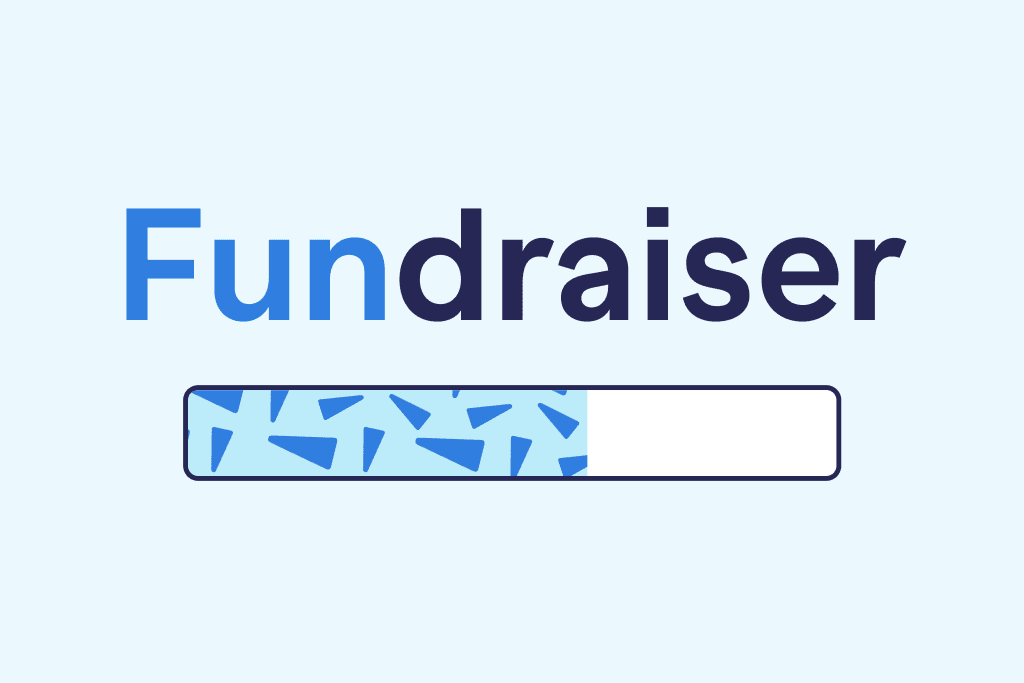Whether you’re a nonprofit raising money for a nation-wide cause or a local school raising money for classroom supplies and field trips, the entire fundraising experience has the same foundational principles. This means that no matter who’s fundraising or what you’re fundraising for, you’re just a few steps away from crushing your goals!
So, let’s get right into showing you how to raise money for any cause.

The basics of fundraising
Fundraising is passion, purpose, and people coming together to make a difference! Whether you’re supporting a local charity, funding a school project, or backing groundbreaking research, fundraising lets you be part of something bigger. It’s your chance to contribute to a cause you care about, even if you can’t be on the front lines.
Before you start, check your local laws—some fundraisers need permits or registrations. Keep it ethical, too: be honest about your cause and avoid guilt-tripping donors.
Trust starts with integrity!
Fundraising key players: meet the team!
Every great fundraiser has a dream team behind it. Here’s who’s who:
Organizations & Nonprofits
These are the heart and soul of fundraising. They’re the ones with the big ideas and the big goals. Their job? To inspire, connect, and show the world why their cause matters.
Donors
Donors are the people, businesses, or foundations who give their time, money, or resources to make things happen. They’re motivated by passion, purpose, or sometimes just the joy of giving.
Volunteers
The ultimate cheerleaders! Volunteers roll up their sleeves, spread the word, and bring the energy. They’re the ones making events happen, knocking on doors, and rallying the troops.
Fundraising Pros
The masterminds! These are the experts who know how to turn ideas into action. They plan, strategize, and make sure every dollar counts.
How does fundraising work? Let’s break it down!
Fundraising is like a recipe—you need the right ingredients and steps to make it work. Here’s the secret sauce:
1. Planning: dream big, plan smart
This is where the magic begins!
- Set clear goals: Know how much you need and what it’s for.
- Understand your project: What’s the mission? Why does it matter?
- Create a timeline: Deadlines keep you on track.
- Build a roadmap: Step-by-step, from start to finish.
2. Execution: let’s make it happen!
Time to bring your plan to life!
- Pick the perfect fundraiser: Bake sales, fun runs, online campaigns—choose what fits your vibe.
- Shout it from the rooftops: Use social media, emails, and good old-fashioned word-of-mouth to spread the word.
- Rally your team: Get volunteers and supporters fired up and ready to go!
3. Monitoring: keep your eye on the prize
Stay on top of things!
- Track progress: How much have you raised? How many people are involved?
- Adjust as you go: If something’s not working, switch it up!
4. Completion: celebrate and say thanks!
Now wrap it up with style.
- Deliver on promises: If you’re selling something, make sure it gets to your supporters.
- Manage the money: Allocate funds where they’re needed most.
- Say thank you: Show your donors and volunteers some love with thank you messages!
Fundraising is about connection, community, and creating change. It’s a chance to turn passion into action and dreams into reality. Every dollar, every hour, every share counts. So whether you’re donating, volunteering, or organizing, you’re making a difference. And that’s something to celebrate!
Getting started: launch your fundraising campaign
Ready to kick off your fundraising campaign? Awesome! The first steps are all about laying a strong foundation. Let’s break it down so you can hit the ground running:
Step 1: Decide what you’re raising funds for
What’s your big idea? Whether it’s funding a community project, supporting a nonprofit, or helping a friend in need, get crystal clear on your purpose. Ask yourself:
- What’s the problem you’re solving?
- Who will benefit from this?
- Why does it matter?
Step 2: Identify your needs and expenses
Time to crunch the numbers!
- List your costs: What do you need money for? Supplies, event space, marketing?
- Set a budget: Know exactly how much you need to raise.
- Be realistic: Don’t aim too high or too low—find that sweet spot.
Step 3: Set a clear mission or objective
Your mission is your North Star. Make it clear, compelling, and easy to share. For example:
- “We’re raising $10,000 to build a playground for local kids.”
- “Our goal is to provide 500 meals to families in need this holiday season.”
Step 4: Align fundraising goals with your cause
Your fundraising goals should match your mission. If you’re raising money for a school, your campaign should feel educational and community-focused. If it’s for a creative project, let your campaign reflect that energy. Keep it authentic!
Step 5: Consider a cost-benefit analysis
Not all fundraisers are created equal. Some cost more time and money than they’re worth. Ask yourself:
- How much will this fundraiser cost to run?
- How much can we realistically raise?
- Is it worth the effort?
Weigh the costs vs. rewards: A gala might cost $5,000 to host but raise $20,000—worth it! A bake sale costing $50 but raising $200 might not scale that well.
Choosing a fundraising method: pick your power move!
Now that you’ve got your plan, it’s time to choose how you’ll raise those funds. Here’s a breakdown of your options:
Traditional fundraising methods
Old-school but gold-school! These methods are tried and true.
Direct Mail Campaigns
- What it is: Sending letters or postcards to potential donors.
- Best for: Reaching older donors or local communities.
- Pros: Personal and tangible.
- Cons: Can be expensive and time-consuming.
Fundraising events (Galas, Auctions, etc.)
- What it is: Hosting a fancy dinner, fun run, or auction.
- Best for: Building community and creating buzz.
- Pros: Great for networking and donor engagement.
- Cons: Requires planning and upfront costs.
Door-to-Door solicitation
- What it is: Knocking on doors to ask for donations.
- Best for: Local causes with strong community ties.
- Pros: Personal and direct.
- Cons: Can be hit-or-miss and labor-intensive.
Digital fundraising methods
Go digital and reach the masses!
Crowdfunding platforms
- What it is: Creating an online campaign to collect donations.
- Best for: Quick, viral fundraising with a wide reach.
- Pros: Easy to set up and share.
- Cons: Platform fees and competition for attention.
Social Media campaigns
- What it is: Using Instagram, Facebook, or TikTok to spread the word.
- Best for: Engaging younger audiences and creating shareable content.
- Pros: Low cost and high visibility.
- Cons: Requires consistent effort and creativity.
Email marketing for fundraising
- What it is: Sending targeted emails to potential donors.
- Best for: Reaching an existing network of supporters.
- Pros: Cost-effective and trackable.
- Cons: Emails can get lost in crowded inboxes.
Corporate sponsorship and grants
Think big and partner up with corporate sponsors!
Approaching businesses for sponsorship
- What it is: Asking companies to support your cause in exchange for recognition.
- Best for: Large-scale projects or events.
- Pros: Can bring in big bucks and build long-term relationships.
- Cons: Requires research and a strong pitch.
Writing grant proposals
- What it is: Applying for funding from foundations or government programs.
- Best for: Nonprofits with specific, well-defined projects.
- Pros: Can secure significant funding.
- Cons: Competitive and time-intensive.
Building partnerships with local businesses
- What it is: Teaming up with local shops or companies for mutual benefit.
- Best for: Community-focused initiatives.
- Pros: Builds local support and visibility.
- Cons: Requires relationship-building and negotiation.
Final Tip: Mix and Match: Don’t be afraid to combine methods. Maybe you start with a crowdfunding campaign, then host a local event to celebrate your progress. The more creative, the better!
Create a compelling fundraising campaign: tips and tricks for success!
Ready to launch a fundraising campaign that turns heads and opens wallets?
A successful campaign is equal parts planning, creativity, and heart. Here’s how to create one that stands out and gets results.
Developing a fundraising plan: start strong!
A great campaign starts with a solid plan. Here’s how to build yours:
1. Set realistic fundraising goals
- Be specific: Instead of “We need money,” say, “We’re raising $5,000 to buy 100 backpacks for kids in need.”
- Break it down: Show how each dollar will be used. For example, “$50 feeds a family for a week.”
- Keep it achievable: Don’t aim for the moon if you’re just starting out. Set a goal that’s challenging but doable.
2. Identify your target audience
- Who cares about your cause? Are they local parents, young professionals, or animal lovers?
- Where do they hang out? Social media, community events, or email inboxes?
- What motivates them? Is it emotional stories, tax benefits, or the chance to be part of something big?
3. Create a timeline for your campaign
- Start and end dates: Keep it short and sweet—30 days is ideal for urgency.
- Milestones: Break your goal into smaller chunks. For example, “Raise $1,000 in the first week.”
Promotion schedule: Plan when you’ll post on social media, send emails, or host events.
Creating engaging campaign content: tell a story that sticks!
Your content is your biggest advantage. Make it impossible to scroll past!
1. Craft a compelling story
- Start with the “why”: Why does this cause matter? Why now?
- Make it personal: Share a real story about someone your campaign will help. For example, “Meet Sarah, a single mom who needs your help to put food on the table.”
- Keep it simple: Use clear, emotional language that anyone can understand.
2. Utilize visuals and multimedia
- Photos: Show real people, real impact. A picture of a smiling child is worth a thousand words.
- Videos: Short, heartfelt videos work wonders. Keep them under 2 minutes!
- Infographics: Use stats and visuals to show the problem and how donations will help.
3. Be transparent and accountable
- Show the numbers: Break down how funds will be used. For example, “80% of donations go directly to food supplies.”
- Share updates: Post progress reports.
- Be honest: If you hit a snag, let people know. Transparency builds trust.
Customize your fundraising page: make it yours!
Your fundraising page is your campaign’s home base. Make it unforgettable!
Many platforms let you design a page that reflects your organization’s unique identity. This personalization helps create a more memorable experience for your donors.
For example, add your logo, choose your colors, and write a compelling message that resonates with your audience. By aligning the page with your brand, you make it easier for donors to connect with your cause.
Custom pages also allow you to tell your story in a way that feels authentic. The more personal and aligned the page feels with your mission, the more likely donors are to give.
- Add your brand: Use your logo, colors, and fonts to make it feel authentic.
- Tell your story: Use your compelling narrative right at the top.
- Include a call-to-action: Make it clear what you want people to do. For example, “Donate now and help us reach our goal!”
- Add visuals: Use photos, videos, and graphics to bring your story to life.
- Show progress: Add a donation tracker to build momentum.
Examples of killer fundraising campaigns
Small-Scale, Grassroots Examples:
Captain Tom Moore’s 100th Birthday Walk (UK, 2020)
What It Is: During the COVID-19 lockdown, 99-year-old WWII veteran Captain Tom Moore pledged to walk 100 laps of his garden before his 100th birthday to raise funds for NHS Charities Together. He aimed for £1,000 but raised over £32.7 million (~$40 million USD) from 1.5 million donors.
Diversity Factor: Engaged a global audience across generations via a simple, personal act amplified by media and social platforms.
Why It Worked: Emotional storytelling (a veteran supporting healthcare workers) paired with a clear, relatable goal.
Takeaway: Small, authentic efforts can snowball with the right narrative and timing.
The Tampon Tax Community Fund (UK, 2018-2022)
What It Is: Local women’s charities in the UK used government funds from the “tampon tax” (VAT) on sanitary products) to run grassroots campaigns, like workshops and donation drives, raising additional funds for period poverty relief. One example: Bloody Good Period raised £250,000+ for menstrual equity.
Diversity Factor: Focused on underserved women and girls, including refugees and low-income communities.
Why It Worked: Addressed a niche, stigmatized issue with direct community impact.
Takeaway: Hyper-local campaigns tied to policy can amplify niche causes.
Mid-Scale, Community-Driven Examples:
Cycle for Survival (USA, Ongoing since 2007)
What It Is: An annual indoor cycling event organized by Memorial Sloan Kettering Cancer Center, where teams ride stationary bikes to fund rare cancer research. It’s raised over $350 million since inception, with $40 million+ in 2023 alone.
Diversity Factor: Attracts fitness enthusiasts, cancer survivors, and corporate teams nationwide.
Why It Worked: Combines physical challenge with a clear mission; strong corporate sponsorship boosts reach.
Takeaway: Active participation events build community and sustained donor commitment.
Movember (Global, Ongoing since 2003)
What It Is: Men grow mustaches in November to raise funds and awareness for men’s health issues (prostate cancer, testicular cancer, mental health). It’s raised over $1.2 billion globally, with campaigns in 20+ countries.
Diversity Factor: Engages men worldwide, breaking cultural taboos around health discussions.
Why It Worked: Fun, visible participation (mustaches) plus a month-long focus drives viral momentum.
Takeaway: Gamify fundraising with a quirky, shareable hook to sustain engagement.
Large-Scale, High-Impact Examples:
Critical Role’s Kickstarter for “The Legend of Vox Machina” (USA, 2019)
What It Is: The tabletop RPG group Critical Role launched a crowdfunding campaign to animate their Dungeons & Dragons series. Aiming for $750,000, they raised $11.3 million from 88,000+ backers in 45 days.
Diversity Factor: Tapped into a global niche of gaming and fantasy fans, transcending typical donor demographics.
Why It Worked: Leveraged an existing fanbase, offered tiered rewards, and delivered a tangible product.
Takeaway: Crowdfunding thrives when you reward donors with something they’re passionate about.
Extra Life (Global, Ongoing since 2008)
What It Is: Gamers play video games, board games, or sports in 24-hour marathons to raise funds for Children’s Miracle Network Hospitals. It’s raised over $100 million since 2008, with $8.8 million in 2022 alone.
Diversity Factor: Unites gamers of all ages and backgrounds for pediatric care.
Why It Worked: Harnesses a passionate subculture (gaming) with peer-to-peer fundraising.
Takeaway: Tap into existing communities with shared hobbies for exponential growth.
Creative and Niche Examples:
The Ocean Cleanup’s Sunglasses Campaign (Netherlands, 2020)
What It Is: The Ocean Cleanup sold sunglasses made from plastic retrieved from the Great Pacific Garbage Patch, raising $7 million to fund further cleanup efforts. Each pair cost $199, with 35,000+ sold.
Diversity Factor: Appeals to eco-conscious consumers globally, blending activism with a tangible product.
Why It Worked: Turned waste into a desirable item; transparency on fund use built trust.
Takeaway: Sell mission-aligned products to merge fundraising with impact visibility.
Wings for Life World Run (Global, Ongoing since 2014)
What It Is: A global running event where participants race a virtual “Catcher Car” that starts 30 minutes after them, ending their run when it passes. It’s raised over €43 million (~$45 million USD) for spinal cord research.
Diversity Factor: Inclusive of runners and wheelchair users worldwide, with 100,000+ participants annually.
Why It Worked: Innovative twist on a charity run with a thrilling chase element.
Takeaway: Add a unique gimmick to traditional formats to boost excitement.
Digital-First Examples:
TeamTrees (Global, 2019)
What It Is: YouTubers MrBeast and Mark Rober launched a campaign to plant 20 million trees by encouraging $1 donations per tree via a digital platform. It raised $20 million in two months, planting 24 million trees by 2022.
Diversity Factor: Reached millions across age groups and countries via YouTube and social media.
Why It Worked: Simple ask ($1 = 1 tree), influencer-driven virality, and real-time progress tracking.
Takeaway: Partner with influencers and simplify donation impacts for mass appeal.
The Bail Project’s Juneteenth Campaign (USA, 2020)
What It Is: A digital campaign tied to Juneteenth, raising $4.6 million in one week to bail out Black protesters and others from jail, leveraging social media and email outreach.
Diversity Factor: Focused on racial justice, resonating with activists and allies during a pivotal moment (George Floyd protests).
Why It Worked: Timely cause, urgent messaging, and transparent outcomes (e.g., 1,500+ people freed).
Takeaway: Align campaigns with cultural moments for heightened relevance and urgency.
The “Global Birthday Pledge” (Inspired by Charity: Water)
What it is: A campaign asking people worldwide to donate their birthdays by requesting gifts to a cause (e.g., clean water access) instead of personal presents. Raised millions globally.
Diversity factor: Reaches donors across cultures, ages, and income levels via social media.
Why it works: Simple concept with universal appeal; leverages personal milestones for collective impact.
Takeaway: Tie fundraising to relatable life events to scale across diverse demographics.
Final tips for success
- Start with your network: Ask friends, family, and coworkers to donate and share.
- Keep the energy high: Post updates, share milestones, and celebrate wins along the way.
Engage with your donors: turn supporters into superfans!
Your donors are more than just wallets—they’re your biggest cheerleaders, advocates, and partners in making a difference. Engaging with them isn’t just polite; it’s essential for spreading the word and building a loyal community. Let’s see how to keep your donors hooked and excited about your cause!
Building relationships with donors: it’s all about connection!
1. Importance of donor recognition
- Say thank you: A simple “thank you” goes a long way. Send personalized emails, handwritten notes, or even shoutouts on social media.
- Public recognition: Highlight donors in newsletters, on your website, or at events. For example, “Thank you to our top 10 donors this month!”
- Exclusive perks: Offer special updates, behind-the-scenes content, or early access to events.
2. Strategies for donor engagement and retention
- Keep them in the loop: Share regular updates about your progress and impact. For example, “Thanks to you, we’ve served 500 meals this month!”
- Invite them to events: Host donor appreciation events, webinars, or volunteer opportunities.
- Ask for their input: Make them feel valued by asking for feedback or ideas.
3. Utilizing donor feedback for improvement
- Listen and learn: Use surveys or casual conversations to understand what donors love (or don’t love) about your campaigns.
- Act on feedback: Show donors you’re listening by making changes based on their suggestions.
- Build trust: Transparency and responsiveness turn one-time donors into lifelong supporters.
Leveraging social proof: show them you’re the real deal!
People trust people. Use social proof to build credibility and inspire action.
1. Showcase testimonials and success stories
- Share impact stories: Highlight how past donations made a difference. For example, “Thanks to your support, Maria’s family now has a safe home.”
- Feature donor testimonials: Let your donors do the talking. “I donated because I believe in this cause—it’s changing lives!”
2. Utilize social media for visibility
- Post regularly: Share updates, photos, and videos to keep your cause top of mind.
- Engage with followers: Respond to comments, and create shareable content.
- Use hashtags: Create a unique hashtag for your campaign to build buzz.
3. Encourage Peer-to-Peer Fundraising
- Empower your supporters: Let them fundraise on your behalf. For example, “Start your own mini-campaign and help us reach our goal!”
- Provide tools: Give them shareable graphics, email templates, and tips to make it easy.
Maximizing your fundraising efforts: go big or go home!
Want to take your fundraising to the next level? Here’s how to squeeze every drop of potential out of your campaign.
Utilizing technology: work smarter, not harder!
Technology is rapidly shaping fundraising!
1. Fundraising software and platforms
Use the right tools: Platforms like RallyUp streamline donations, while AI can predict who’s likely to give again. Want to wow donors? Try a VR tour of your project’s impact!
- Streamline processes: Automate emails, track donations, and manage donor data all in one place.
2. Tracking donations and donor engagement
- Monitor progress: Use dashboards to see how much you’ve raised and who’s donating.
- Segment your donors: Categorize donors by amount, frequency, or engagement level to tailor your outreach.
3. Analyzing campaign performance
- Measure success: Track metrics like donation amounts, social media engagement, and email open rates.
- Learn and adapt: Use data to see what’s working and what’s not, then tweak your strategy.
Best practices for successful fundraising: the golden rules!
1. Importance of Follow-Up
- Don’t ghost your donors: Follow up after the campaign to share results.
- Make it personal: A handwritten note or personalized email can make a donor feel truly appreciated.
2. Learning from past campaigns for future success
- Review and reflect: What worked? What didn’t? Use these insights to improve your next campaign.
- Celebrate wins: Acknowledge your team’s hard work and build on your successes.
How to start raising money for your cause
Here’s a quick guide to get you started:
Make your fundraiser stand out: be unforgettable!
- Be unique: What makes your fundraiser different? A creative twist or a bold goal can grab attention.
- Tell a story: People connect with emotions, not statistics. Share why your cause matters.
- Show impact: Use visuals, testimonials, and data to prove your campaign is worth supporting.
Now it’s your turn! With these tips, you’re ready to create a fundraising campaign that inspires, engages, and delivers results.
Make your fundraiser stand out
You can’t spell fundraiser without “fun”, which is exactly what your goal should be with all of your campaigns! Yes, you want to put on a fundraiser that has crazy potential to raise a lot of money, but in order to do that, it needs to be something people will actually enjoy. It has to be something that people would have interest in, let alone donating their money to.
When you’re in the planning stages of your fundraising campaigns, it’s essential that you put yourself in the shoes of the donor. Consider questions like:
- Would I spend my free time at an event like this?
- What would make me want to participate in a charity fundraiser?
- What kinds of things would encourage me to attend something like this?
- Would I bring my family to this fundraiser?
You can start by considering different fundraising experiences–you know, something a little more outside-the-box than crowdfunding! We’re talking fundraisers like:
- Raffles – where you raffle off different prizes for donations
- Sales – where you sell items for donations
- Events – where you sell tickets for donations
- A-Thons – where you have participants pledge for donations
The good news is that when you use an online fundraising platform, like RallyUp, you can easily throw more creative fundraisers like these with ease! Remember, the more memorable, the better.

Creative Fundraising Ideas
There is no shortage of fundraising ideas out there. One thing to think about is the time of year. Are there any holidays coming up, or new seasons? You can align the theme of your fundraiser to the time of year to make it even more fun.
If you need a little bit of inspiration, these might get your wheels spinning a little bit:
- Date Night with an Athlete for college sports teams
- A Beach Clean Up Event for environmental charities
- All Things Pumpkin Bake-Off for the fall season
- A Fancy Dress Race for football teams
- A Guess-That-Go A-Thon for Halloween
The sky really is the limit when it comes to all the different fundraisers you can do. And it makes a world of a difference when you use the tools and resources available to you to make your life easier!

Storytelling is the heart of fundraising
Want to inspire more donations? Tell a great story!
Storytelling is one of the most powerful tools in fundraising. A compelling narrative about your cause can connect emotionally with donors and drive them to act. Share the journey, the people, and the impact of your work. Make it personal. Show what’s at stake and why it matters.
Here’s a tip: start with a hook. Grab attention with a powerful opening, then take your supporters through a story they can relate to. Include real-life examples, challenges, and triumphs. The more vivid the story, the more likely people are to engage and give.
Keep it authentic. People support causes they believe in—and they believe in stories that feel real and relatable. If you’re asking how to raise money fast, storytelling is one of the most effective tools to do so.

Multilingual campaigns allow for global reach
Running a fundraising campaign for an international audience? Awesome! But don’t forget to adapt your strategy for global success. One of the keys to reaching a wider audience is offering multilingual options. Adding different language versions of your campaign page helps break down language barriers and invites more people to donate.
For international donations, make sure your platform supports multiple currencies and payment methods. This ensures donors from anywhere in the world can contribute easily. You want your campaign to feel local, no matter where your donors are.
Double your fundraising impact with online and in-person giving
Why choose one way to raise money when you can do both? Imagine an Event that’s full of energy—whether it’s a glamorous gala, a fun Auction, or a virtual bash—where online giving flows just like in-person donations.
With the right tools, you can sync registration, ticket sales, and donations all in one place! Guests can grab tickets, donate on the spot, and even bid on Auction items—all in real-time! It’s an interactive, high-energy experience that makes giving simple and fun.
This approach is an excellent way to raise money fast while reaching a broader audience.
Peer-to-peer fundraising: Let your supporters do the work for you
Want to expand your reach and raise even more money for your cause? Peer-to-Peer fundraising is the perfect way to do it!
This strategy lets your supporters create their own personal fundraising pages for your campaign. They can share their pages with family, friends, and followers.
Peer-to-Peer is a way to fundraise money for your cause through personal networks. The more people involved, the bigger your impact.
With Peer-to-Peer fundraising, each personal page acts as a mini campaign, spreading the word about your cause and encouraging donations. It’s like having a team of passionate fundraisers working for you, making it easier to reach new donors and raise more funds.
So, let your community help you out and watch your fundraising grow!
Partner up for greater impact
Want to take your campaign even further? Build partnerships with established nonprofits, organizations or influencers. These partnerships can give your cause a huge jump in credibility and exposure, allowing you to raise money faster. When trusted organizations or influencers share your campaign, their followers take notice. It’s a fast way to expand your reach and tap into new donor pools, making it easier to raise money for a good cause.
By teaming up, you can also pool resources, collaborate on content, and create joint promotions. This not only raises awareness but also builds trust with potential donors. So, don’t be shy—reach out!
Collaborate with Influencers
Whether they have thousands or millions of followers, influencers can share your campaign in a way that feels personal and authentic.
After all, 92% of consumers trust influencer recommendations over brand advertisements, making influencer-generated content highly persuasive.
Work with influencers who align with your values. They can post about your fundraiser, encourage donations, and even host live Events or challenges. The result? More visibility, more donations, and more excitement surrounding your campaign.
Make it easy for influencers to share by providing ready-to-go content. The easier you make it for them, the more likely they’ll be to help spread the word.
If you’re wondering about the best way to raise money for your campaign, influencer partnerships are a strong option.
Leverage your resources
When you’re trying to figure out how to raise money for any kind of cause, creativity is one thing, but, tapping into the resources available to you is another! Any area where you can be more efficient by saving time, or money, is your golden ticket to success. If it can make your life easier, why not take advantage of it?
A Solid Fundraising Platform
Traditionally, fundraisers have been pretty manual. And we’re sure you know that already! There’s always been lots of pen to paper, right? Not only that, but somewhat of a limit to your reach and the types of fundraisers you can easily pull off.
Fortunately, online fundraising platforms exist to solve some of those problems. There are quite a few out there, but you’ll always want to look out for ones that:
- Give you the ability customize the look and feel of your fundraiser
- Give you the flexibility to choose different types of fundraisers
- Are able to easily collect payments from donors for you
- Provide a seamless experience for your donors to donate
- Don’t charge you fees to use their services
Just a little fun fact, RallyUp’s online fundraising platform does all of these things and more. We’re basically a one-stop shop for your fundraising needs and don’t charge you a dime.
Free (Or Low Cost) Marketing Tools
Once you’ve got your fundraiser all figured out, you need efficient (and thrifty) ways to spread the word! Marketing your fundraiser is almost just as important as the fundraiser itself. How are people going to participate (aka donate) if they don’t know about it?
This is another perfect opportunity to utilize the resources that are out there just waiting for you to come knocking at their door. A lot of marketing tools are free and really pack a punch when it comes to value.

Some of our favorites are:
- MailChimp – A free email marketing platform that allows you to create beautiful emails in a super easy editor to send to your entire database at once. Their drip campaign functionality allows you to set up custom, automated email campaigns that you can set and forget.
- Canva – A free, online design tool where you can make basically anything and everything, from social posts and flyers to brochures and postcards. They have thousands of really nice templates to choose from so basically no design skill is actually needed from you.
- Social Media – Let’s not forget that social media is also a free resource! And a super effective one considering that people spend an average of 2.5 hours on social media every day. Your social media strategy should be one of the most prioritized marketing initiatives for your entire campaign. Post on all your platforms, every day, and engage with your followers the whole time.
Your Helpful Community
When we talk about leveraging the resources available to you, they don’t always have to relate directly to technology. You also have human resources you can lean on to be more efficient, save time, and money too! Fundraisers need all the manpower they can get.

You can always rely on:
- Your volunteers – No matter what kind of help you may need for your fundraiser, you should always reach out to your volunteers for a helping hand. It’s a good idea to be recruiting volunteers all throughout the year so you can have a good amount on standby waiting to help!
- Local community businesses – A lot of successful fundraisers involve some sort of prize or reward for donors who participate! Like an a-thon fundraiser, for example, where people are competing against each other for the top spot. In these situations, you can reach out to local businesses and see if they’d be willing to donate their products or services to use as prizes, rewards, or even raffle items.
- Your staff: It’s all hands on deck for your fundraising efforts! Which includes your staff. Tap in as many people that are willing and integrate them into different areas of your campaign based on their individual strengths. To encourage the most participation, consider offering some extra time off or order some pizzas when you all work on the fundraiser together.
Keep the Momentum Going
Don’t let your campaign end with the last donation. Keep the momentum going! Send out thank-you notes to your supporters. Show them exactly how their contributions made a difference. You can create an impact report or a campaign recap that highlights key achievements. This shows them the real-world effects of their generosity.
This follow-up is critical for building long-term relationships. It’s about keeping your community involved and excited for the next campaign.
Top-performing nonprofits have achieved a donor retention rate of nearly 70% by actively investing in relationship-building activities, leading to consistent support. But why, you may ask?
Larger nonprofits typically have better donor retention rates because they have more resources to maintain relationships. In contrast, smaller nonprofits may face challenges in keeping donors, often due to reliance on major donors or the absence of recurring giving programs.
Think about it: recurring donors are more likely to advocate for your nonprofit to family, colleagues, and friends. This way, they amplify your fundraising cause through word-of-mouth promotion.

Donor Stewardship: Keep the Relationship Strong After the Campaign
Fundraising doesn’t stop when the campaign ends. The real work begins in maintaining the relationship with your donors. Donor stewardship is all about keeping your supporters engaged long after they’ve donated. Send personalized notes to show your appreciation. Keep them updated with progress reports and success stories about how their contributions are making a difference.
Lori Gusdorf, Executive Vice President of the AFP Foundation for Philanthropy, said: “The challenge as I see it is to understand what separates high-performing organizations from those that struggled…. What did they do that differentiated them from those that saw significant declines in giving?”
It’s clear that large, repeat donors play a significant role in keeping fundraising totals up. So, stewardship of major donors is a must. However, relying too heavily on just a few big donors can make a nonprofit more vulnerable. If one of these major donors decides to give their money elsewhere, the nonprofit could face a significant loss.
Plan for regular engagement—send out impact reports or host special events for loyal donors.
By keeping your supporters in the loop, you’ll build long-term relationships. This ongoing communication makes donors feel valued and strengthens their connection to your cause.
Don’t let their generosity fade away; keep the momentum alive!
Don’t forget transparency and trust: why transparency matter
Transparency isn’t just a buzzword—it’s the foundation of donor trust. When people give their hard-earned money to your cause, they want to know it’s being used wisely.
Here’s why transparency matters and how to make it a priority in your fundraising efforts.
1. Builds donor trust
- Trust = loyalty: Donors who trust you are more likely to give again and again.
- Be open: Show donors exactly where their money is going and how it’s making an impact.
2. Encourages more donations
- Confidence inspires action: When donors see transparency, they feel confident about giving.
- Word spreads: Trustworthy organizations attract more supporters through word-of-mouth and social proof.
3. Strengthens your reputation
- Credibility is key: Transparent organizations are seen as credible and professional.
- Stand out: In a sea of fundraisers, transparency sets you apart.
How to be transparent: show, don’t just tell
1. Share regular updates
- Keep donors in the loop: Post updates on your website, social media, or email newsletters. For example, “Thanks to your donations, we’ve built 3 new classrooms!”
- Celebrate milestones: Highlight progress and thank donors for their role in your success.
2. Be clear about how funds are used
- Break it down: Use visuals like pie charts or infographics to show how donations are allocated. For example, “80% goes to program costs, 10% to admin, and 10% to fundraising.”
- Tell stories: Show real-life examples of how donations are making a difference.
3. Provide clear financial reports
- Share annual reports: Publish detailed financial statements that show income, expenses, and impact.
- Be accessible: Make reports easy to find on your website or available upon request.
4. Quick tips for building trust
- Be honest: If something goes wrong, own up to it and explain how you’re fixing it.
- Invite questions: Encourage donors to ask questions and provide clear, timely answers.
Diversifying your funding sources
Don’t put all your eggs in one basket. A diversified funding strategy is a solution for long-term success. While one revenue stream might bring in donations, combining several can significantly magnify your fundraising efforts.
A study by Nonprofit Hub suggests that nonprofits should aim for no more than 20% of their income to come from any single source, excluding individual donations.
Another research from Stanford Social Innovation Review indicates that over 90% of large U.S. nonprofits (with revenues over $50 million) derive the majority of their income from a single revenue category, averaging 90% of total revenue.
Essentially, their financial stability is largely tied to just one type of funding—whether it’s government grants, corporate sponsorships, or donations from a few large donors. This leaves them highly dependent on just one source and can create risks if that revenue stream were to be disrupted or reduced.
For example, you might host a fundraising gala for high-level donors, launch a Crowdfunding campaign for grassroots support, and apply for grants to back specific projects. At the same time, you could secure corporate sponsorships to keep funds flowing.
By diversifying, you protect your campaign from unexpected shifts and keep your revenue steady. You also open up more opportunities for different donors to get involved.
Diversifying isn’t just smart—it’s indispensable for creating a trustworthy fundraising model. Having a well-rounded fundraising strategy is the best way to raise money!
Maximize your fundraising efforts
If you want your nonprofit to thrive, relying on just one funding source isn’t enough. To keep the momentum going, you need a mix of revenue streams.
Individual Donations
To raise money for a cause, it’s important to connect with both major and regular donors. Start by understanding your donors. Who are they? What motivates them? Identify your top contributors and tailor your approach. Don’t forget about regular donors—they’re the backbone of your campaign.
For major donors, build strong relationships. Over a five-year period, the average nonprofit can see a 127% increase in recurring donors, as stats show. Recent data also indicates a decline in the number of donors across various categories, except for “supersize” donors (gifts over $50,000), which remained stable.
Apply for a Grant
Grants are a solid way to fund specific programs or projects. Foundations, government agencies, and private organizations offer funding for nonprofits. The process can be competitive though, but if you make strong proposals, grants can bring in large sums.
Many nonprofits rely on grant funding at some point. Public researchers and hospitals, for instance, couldn’t stay afloat without stacks of grants. It sounds a little intimidating at first, but while grant writing involves some serious effort, it’s not rocket science. If you do your research and take the right steps, applying for a grant is a stellar way to get the cash you need–stat.

What is a grant?
In the simplest terms, it’s financial support from a private or governmental institution for a specific project, person, activity, or program. Grantmakers tailor their financial support to the nature of the scheme you’re applying for. If you’re building a particle accelerator, you’ll need to score billions of dollars. If you’re building a neighborhood animal shelter, you’ll be looking for a lot less.
Why apply for a grant?
Aside from the obvious–free money, duh–a grant enhances your organization’s reputation. The ability to attract and secure funding from big shot institutions sends a loud signal to your supporters that your mission is worth investing in.
What types of grants are there?
Grants take two main forms.
- General Purpose Grants: A general purpose, or operating support, grant goes toward the cost of keeping your nonprofit humming on a day-to-day basis. It’s an open-ended gift, meaning you can use it to pay your staff, bankroll your next craft sale, or just save it for a rainy day.
- Program Support Grants: Grantmakers award program support grants for a specific activity. This is a restricted form of funding, meaning that you can only use it for the project you applied for, and only within a specific time frame. Let’s say you apply for a grant to run an after-school art program. You’ll receive a certain amount to be used exclusively for artsy activities, from January to May, for example.
How can I get a grant?
- Do your homework: Obtaining a grant begins with research. Consider your nonprofit’s needs, location, and program type. Then narrow your search radar to foundations that have a strong history of supporting your cause. Many grant organizations only award funding in specific geographic locations, or for certain types of programs.
For example, the Stewardship Foundation prioritizes grants to faith-based organizations operating in Washington, while the Frederick W. McCarthy Family Foundation prefers to award those programs that are dedicated to educational organizations around the globe. Use free grant databases like https://grantgopher.com/Grants-for-Nonprofits and grants.gov to search for available grants; paid databases like GrantWatch offer more options.
- Write a grant proposal: The actual process of putting together a grant proposal can seem daunting. After all, that’s why organizations hire certified grant writers, right? Yes and no. You can certainly go the professional route, and there are plenty of grant writers to choose from. But if you’re dedicated and determined, you can write the thing yourself. Yes, you can.
Keep the following in mind:
- Tailor your proposal to the institution. Don’t just blast out a cookie cutter proposal to every grantmaker in the country and expect to get a reply. Does the foundation jive with your mission? Great, explain why. If you admire what they stand for, say so–briefly!
- Read the instructions. Most funders will have straightforward, detailed requirements for how to apply. Follow their instructions to the letter, don’t cut corners, and submit way before the deadline.
- Have clear dates and budgets. Does your organization eat through $300 in heating every month? Do you intend to have that historical house museum re-painted by Christmas? Be very, very clear about costs and timeframes.
- Include a cover letter. First impressions count. Include a simple, to-the-point letter that summarizes your goals and is addressed to a specific person. Never send letters that open with “To Whom It May Concern” or “Dear Sir or Madam” – it’s unprofessional and shows that you didn’t do your research.
- Put yourself in their shoes. Grantmaking bodies receive thousands of applications. Make it easy on them. Don’t make your reader hunt through your documents for a budget breakdown or wade through dozens of testimonials. Be clear, straightforward, and concise.
Corporate Sponsorships
Corporate sponsorships are a win-win. Companies are often willing to sponsor Events or offer matching gifts to their employees. These partnerships bring in money while increasing your visibility. When a business backs your cause, they share it with their networks, expanding your reach.

Example: A nonprofit hosting an annual 5K run partners with a local tech company for corporate sponsorship. The company provides a large donation in exchange for branding at the Event, social media mentions, and logo placement on race t-shirts.
Corporate support comes in many forms, each offering unique ways to strengthen your nonprofit’s mission.
- Philanthropic Donations
Just like individual donations, these are no-strings-attached contributions from companies. - Event Sponsorship
This is short-term support tied to a specific Event, like a charity gala or 5K run. Companies contribute money in exchange for brand visibility during the Event. - Cause Marketing
A longer-term partnership where companies align their brand with your cause. They promote your nonprofit in their marketing campaigns, driving awareness and support. - Pro Bono Services
Companies offer their professional expertise and services for free. This could include legal advice, marketing support, or IT services—anything that helps reduce your operational costs. - Matching Gifts
Corporate matching gift programs double the impact of donations made by employees. When an employee donates, the company matches the gift. - Paid Release Days
Some companies give employees paid time off to volunteer. This allows staff to contribute to your cause during work hours, offering valuable hands-on help without losing income. - In-Kind Gifts
Instead of cash, companies donate products or services. This can include anything from office supplies to technology, helping you reduce expenses. - Check-Out Campaigns
Customers donate to your cause while shopping. At the register, shoppers can round up their bill or add a small donation to support your mission.
Host a Fundraising Event
Events like galas are a fun way to raise money for a cause and connect with your community. They also help create excitement around your cause. Combine your Events with online donations for even more reach. The more people involved, the more donations you’ll receive.
Example: A children’s hospital organizes a yearly charity gala, complete with a silent Auction, live entertainment, and a fundraising dinner. They integrate an online donation page that allows guests to give in real-time during the Event. The hospital also promotes the Event on social media to increase participation from supporters who can’t attend in person.

Start a Membership Program
Membership programs give you a regular, steady income. In exchange for a membership fee, your supporters get exclusive perks like early access to Events or special content. These programs create a loyal group of donors who stay connected and engaged. When they feel part of your community, they’ll keep giving.
Example: A local museum creates a membership program that offers tiered benefits: basic members receive free entry for one year, while premium members get VIP Event access and invitations to exclusive exhibitions.
In-Kind Donations
Not all gifts are cash. In-kind donations are non-monetary gifts, like goods, services, or volunteer time. Local businesses might donate supplies, or professionals might offer pro bono services. These donations lower your costs and stretch your fundraising dollars.
Example: A food bank partners with local grocery stores, restaurants, and farms to receive in-kind donations of food and supplies. A local company donates their warehouse space for free, reducing overhead costs. Volunteers donate thousands of hours annually to sort and distribute food, ensuring that more funds can go toward purchasing additional food for the community.
Alumni & Volunteers
Don’t overlook the power of your alumni and volunteers. Alumni and volunteers are often some of your most loyal supporters.
For example, a university could engage alumni by promoting a “giving day” where graduates contribute back to their alma mater. They can do so through an online campaign with easy donation links.
Volunteers, too, can become major contributors in the long term. Many volunteers feel a deep connection to your cause and may want to offer financial support once they’ve seen firsthand the work you’re doing. By staying in touch and offering meaningful ways for them to get involved, you can turn these loyal supporters into donors.
Engage with these groups and turn them into long-term donors by keeping them informed, involved, and appreciated. This is one way to raise money for a cause that will generate long-term support.
Capital Campaigns & Text-to-Give
Capital campaigns are ideal for raising funds for major, long-term projects like building a new facility or expanding services. For example, a local animal shelter might run a capital campaign to raise funds for a new adoption center. They could target large donations from major supporters and show potential donors the tangible impact of their contributions, such as naming opportunities for rooms or buildings.
Example: A university is launching a capital campaign to raise $5 million for a new campus building. They target major donors and alumni, offering recognition on donor walls and naming rights for larger contributions.
Capital campaigns often run for a few years, allowing nonprofits to reach out to multiple donor segments for support. If your nonprofit has a big goal, this is the best way to raise money.
Text-to-Give is a quick and easy way to collect donations, especially at Events. For instance, a nonprofit hosting a charity run could display a simple “Text [KEYWORD] to [NUMBER]” sign.
Attendees can text in donations from their phones in seconds. A campaign might also use Text-to-Give for emergency fund drives, encouraging people to donate on the spot during a live broadcast.
Keep in mind that it takes an average of 90 seconds to respond to a text message, compared to 90 minutes for email, and that over 50% of people visit nonprofit websites on their mobile devices.
Example: A disaster relief organization sets up a Text-to-Give campaign during a national emergency. By texting “GIVE” to a short code, donors can contribute $10 instantly via their phone bill.
This method is perfect for reaching busy supporters who may not be able to attend in person but still want to contribute. It’s fast, easy, and accessible. It’s great for Events or campaigns, especially when paired with social media. This is a quick way to raise donations for charity and get people engaged right away.
By tapping into these funding sources, you’ll create a strong, sustainable financial model for your nonprofit. Diversifying your revenue streams means more stability and more opportunities!
Planned Giving
This advanced fundraising technique lets donors commit to contributing in the future, often through bequests, retirement funds, or life insurance.
For example, a donor might include your nonprofit in their will, directing a portion of their estate to your cause. Or, they could designate your organization as a beneficiary of their life insurance policy. Some donors might also choose to contribute part of their retirement funds, like an IRA or 401(k). These types of gifts ensure ongoing support for years to come and allow your donors to leave a meaningful legacy.
Planned gifts are significantly larger than annual donations. A typical planned gift is 200 to 300 times the size of a donor’s largest annual gift. Also, bequests are the most common form of planned giving and have shown resilience, with a 4.8% increase in the previous year, totaling over $42.68 billion.
By offering options like legacy donations, you show them how their contribution can live on, making them feel connected to your cause for years to come.

Recurring Donations
Want a steady stream of funding? Focus on recurring donations! Instead of relying on one-time gifts, recurring donations create reliable income over time.
The average donor retention rate for nonprofits is approximately 50%, meaning half of the donor base may need to be replaced every year.
Nonprofit organizations often focus on keeping their current donors because attracting new ones can be expensive. It can take up to 2 years to recover the costs of recruiting a first-time donor, as initial donations are usually smaller than the marketing expenses.
So, offer donors the option to set up monthly or yearly donations. This gives them an easy way to stay involved while providing your organization with predictable support. Make it simple to sign up and track their contributions.
By securing recurring donations, you build a foundation for the future.
Cross-Platform Fundraising
Running a cross-platform campaign means using different platforms to engage more donors and raise more funds. Think social media, email marketing, Crowdfunding sites, and even your own website. By spreading your efforts across various channels, you increase visibility and make it easier for supporters to donate however they prefer.
For example, you could launch a Crowdfunding campaign on platforms like RallyUp, promote it on your social media channels like Instagram and Facebook, and follow up with personalized emails to your existing supporters. You might even integrate donation options and offer special incentives through text messaging or WhatsApp.
To keep track of all your efforts and manage donor data, you can integrate popular CRM and donor management tools like Salesforce or Bloomerang. These tools help you store donor information, track engagement, and streamline communications.
But there’s a balance. While a multi-channel approach can reach more people, it can also lead to overlapping messages or extra management time. Ensure your platforms are all working together, not against each other. Track what’s working best on each channel and double down on those strategies.

Quick-and-Easy Fundraisers
While some fundraisers need a huge budget just to get off the ground, the quick-and-easy ones just take a dedicated team of volunteers and a bit of planning. Here are a few unique fundraising ideas to get you started.

- Live Stream an Activity: Do something for 24 hours and stream it. 12 hours works, too. What should you do? Anything. Seriously. It can be challenging–think tap-dancing or playing bongo drums–or super easy, like reading aloud from Alice in Wonderland. You can perform your activity alone in your living room, or have volunteers take turns. Collect pledges based on hours, pages, or laps.
- Share Your Skills: Take a skill set inventory in your organization. Can anyone play guitar, make origami flowers, or cook a divine pot of chili? Is anyone a whiz at Photoshop? Did anyone play football in college or speak a second language? Pool your talents together and organize a skills workshop. Pick an entire day—or a weekend!—and ask for donations from supporters in exchange for teaching them something fun. This works both in-person and online.
- Get Crazy: This is a hit with kids. Get the word out on your social media page that your team will do crazy things for sponsorships. How much will donors give to see you stand on your head? Belt out all the words to a Beatles song? Keep three oranges in the air for five minutes? The sillier the better. Best of all, you can sell tickets to your Mad Hatter Show and host it online, via platforms like Zoom, Google Hangouts, or fundraising platforms. It gets everyone laughing and won’t cost you a penny.
- Plan A Parents’ Night Out: Moms and dads deserve a break sometimes. Recruit a team of volunteers and scope out a local neighborhood space, like a school gym or a community center. Organize a night of fun activities for kids of all ages, from building Lego towers, to playing dodgeball, to reading ghost stories. Provide healthy snacks or a popcorn machine. Invite parents to drop off their children for the evening, charging a pre-advertised fee (e.g. $30 per visitor). To build anticipation, have families cast their vote on your fundraising page about which movies to screen, which board games to play, or what books to read. If the night is a big hit, you can plan one every month!
Common fundraising challenges
Fundraising isn’t always smooth sailing. From donor fatigue to economic shifts, challenges can pop up when you least expect them. But don’t worry—every challenge has a solution. Let’s break down the most common hurdles and how to overcome them.
1. Donor fatigue
The Challenge:
Donors are bombarded with requests from countless organizations, leading to burnout and decreased giving.
The Solution:
- Focus on quality, not quantity: Send fewer, more meaningful messages.
- Show impact: Remind donors how their contributions make a difference.
- Mix it up: Offer new ways to get involved, like volunteering or peer-to-peer fundraising.
2. Building trust
The Challenge:
Donors want to know their money is being used wisely, but not all organizations are transparent.
The Solution:
- Be transparent: Share clear financial reports and updates on how funds are used.
- Tell stories: Show real-life examples of your impact.
- Engage personally: Build relationships through thank-you notes, calls, or events.
3. Economic changes
The Challenge:
Economic downturns or inflation can make donors tighten their wallets.
The Solution:
- Offer flexible giving options: Monthly donations, small amounts, or in-kind gifts.
- Highlight urgency: Show why your cause is critical, especially during tough times.
- Focus on loyal donors: Strengthen relationships with existing supporters who are more likely to give consistently.
4. Maintaining relationships with donors
The Challenge:
Keeping donors engaged after they’ve made a contribution.
The Solution:
- Say thank you: Always acknowledge donations with gratitude.
- Provide updates: Share progress and success stories regularly.
- Involve them: Invite donors to events, surveys, or volunteer opportunities.
Handling rejection and setbacks
Not every ‘no’ is personal—keep going! If a storm cancels your event, pivot fast: go live online or reschedule with a bigger push. Fundraising can be emotionally taxing, so planning backup strategies will empower you to push through.
The future of fundraising: what’s next?
Fundraising is evolving fast, and the future is looking digital, dynamic, and donor-focused. Here’s what’s on the horizon:
1. Shift towards digital platforms
- Why it’s happening: Digital platforms are convenient, accessible, and cost-effective.
- What it means: Organizations will rely more on crowdfunding, social media, and email campaigns to reach donors.
- How to adapt: Invest in user-friendly fundraising tools and build a strong online presence. Start small—test a crowdfunding page this month. Host a live stream next week to practice going virtual.
2. Increasing number of online fundraising events
- Why it’s happening: Virtual events are cheaper, easier to organize, and can reach a global audience.
- What it means: Galas, auctions, and charity runs are moving online.
- How to adapt: Get creative with virtual events—think live streams, online auctions, or gaming marathons.
3. Donors feeling more comfortable donating digitally
- Why it’s happening: Digital payments are secure, fast, and becoming the norm.
- What it means: Cash and checks are taking a backseat to online donations, mobile wallets, and text-to-give options.
- How to adapt: Offer multiple digital payment options and make donating as easy as clicking a button.
Bonus trend: personalization is key
- Why it’s happening: Donors want to feel valued, not like just another name on a list.
- What it means: Tailored messages, and customized giving options will become the standard.
- How to adapt: Use donor data to create personalized experiences and build stronger connections.
Embrace change and stay ahead!
The future of fundraising is all about innovation, flexibility, and putting donors first. By staying ahead of trends and tackling challenges head-on, you’ll not only survive but thrive in the ever-changing world of fundraising. So, gear up, get creative, and let’s shape the future together!
Ready to start fundraising?
Starting to feel like you know how to raise money for any kind of cause now? Good! That’s exactly what we were aiming to do. And if you want to make your life a whole lot easier, consider leveraging a killer online fundraising platform, like ours, that you and your donors will love.
If you enjoyed this article, you might also like:
- Comprehensive Fundraising Strategy and Plan
- Corporate sponsorship: the complete guide for nonprofits
- What is Conversion Rate? How to Calculate and Use Conversion Rate
- Nonprofit ratios: considering your fundraising efficiency
- Cost-effectiveness in Fundraising: How to do a Cost-Benefit Analysis and Why it’s Important
